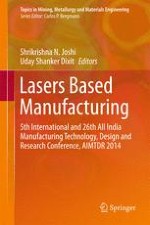2015 | Book
Lasers Based Manufacturing
5th International and 26th All India Manufacturing Technology, Design and Research Conference, AIMTDR 2014
Editors: Shrikrishna N. Joshi, Uday Shanker Dixit
Publisher: Springer India
Book Series : Topics in Mining, Metallurgy and Materials Engineering
